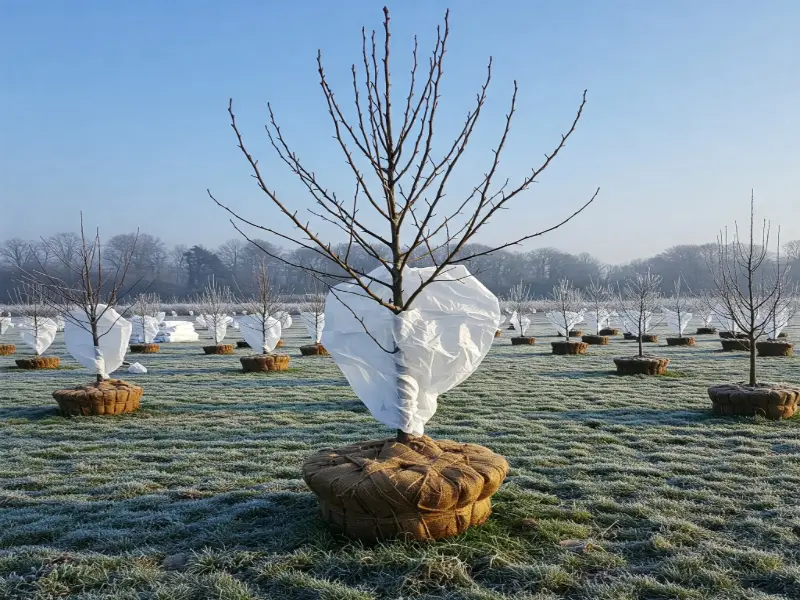Winter is not a friendly season for trees; usually, it is a challenging season for them. The most common issues in winter are freezing temperatures, heavy snow, ice storms, and strong winds. Due to these environmental conditions, they can cause physical damage to branches, trunks, and even roots. Young or newly planted trees can be big victims of winter, and they may suffer from frost cracks, bark splitting, dehydration, and winter burn. Even the mature trees sometimes cannot tolerate this, and they also struggle with winter stresses.
That’s why experts always say tree care in cold weather help your trees survive and thrive. Before the winter season arrives, you should plan what you need to do. With proper preparation, you can prevent costly damage, disease, and even tree loss.
In this guide, we are going to show you how to protect trees in winter and how to help them survive during this harsh weather season. So, let’s start and check how you can protect your trees with the proper winter tree protection tips.
Common Winter Threats to Trees
Winter brings several serious challenges for trees, and understanding these threats is the first step in winter tree damage prevention. One of the most common problems is frost cracks, which happen when sudden temperature changes cause the tree’s bark to expand and contract quickly, leading to long vertical cracks in the trunk. Another common issue is tree bark splitting in winter, especially on young or thin-barked trees.
Heavy snow and ice build-up can also cause significant damage to branches. The weight of snow or ice can bend, crack, or even break large limbs, creating not only health issues for the tree but also safety risks around your property.
Strong winter winds and freezing temperatures add even more stress. Harsh winds can strip moisture from branches and leaves, leading to winter burn or dehydration. Roots are also at risk; if the ground freezes deeply, it limits the tree’s ability to absorb water, especially for younger trees with shallow roots.
Understanding these threats highlights the importance of tree care in cold weather. By knowing what your trees are facing, you’ll be better prepared to take action and provide the right winter tree protection to keep them healthy through the season.
If a tree unexpectedly crashes onto your home or yard, don’t panic. Read our guide on Emergency Tree Services: What to Do When a Tree Falls on Your Property to learn the safest and smartest next steps.
Steps to Prepare Trees Before Winter Hits
As we know already, we need to prepare for the winter; if not, trees might not withstand that harsh weather, and we’ll have to face some tough consequences. So, let us give you some simple but essential tips to protect and strengthen your trees and minimize the risk of winter damage.
Mulching Trees Before Winter
Applying a generous layer of mulch around the base of your trees is one of the best winter tree protection tips. Mulch acts as an insulating blanket, helping to regulate soil temperature and prevent sudden fluctuations that can stress tree roots. It also retains vital moisture in the soil, which is especially important during the dry winter months. Aim for a 2-4 inch layer of organic mulch, keeping it a few inches away from the trunk to avoid rot.
Pruning for Winter Storm Protection
Late fall is an ideal time to prune your trees. Focus on removing weak, damaged, or dead branches that could easily break under the weight of snow and ice. Proper pruning not only helps with winter storm protection for trees but also promotes healthier growth when spring arrives. By reducing the risk of branch breakage, you protect both your trees and your property.
Watering Trees in Late Fall
Most people think watering in the winter isn’t needed. But the truth is, winter watering for trees is a major part of tree maintenance in the colder months. The best practice is to give your trees a deep watering to prevent dehydration during the cold months.
Wrapping Tree Trunks for Cold Protection
If you have young trees in your garden, then wrapping their trunks is one of the most effective and smartest ways to protect them during winter. It helps the trees avoid freezing damage and stops bark from splitting due to rapid temperature changes. During the daytime, the sun warms the bark, but on very cold nights, the bark contracts too quickly, leading to cracks and injuries. To avoid this, wrapping is a great option.
Now, you may wonder what to use to wrap trees in winter?
There are a few reliable options, including burlap, commercial tree wrap, or special winter fabrics. When you wrap the tree correctly, it helps prevent moisture buildup while still allowing the tree to breathe properly.
So here are three simple steps to wrap your tree the right way:
Start wrapping your tree trunks in late fall, just before the first frost sets in.
Wrap from the base of the tree all the way up to the lowest branches. For young trees, go up at least to the first set of limbs to give full coverage.
As soon as the threat of frost has passed and temperatures begin to stabilize, usually in early spring, remove the wrap to prevent trapping moisture and to let the tree breathe freely.
Insulating Trees for Winter & Shielding from Frost

Winter winds and freezing temperatures can be brutal for your trees, especially young or sensitive ones. That’s why insulating trees for winter is so important to keep them safe and healthy. One effective method is using burlap screens to protect trees from harsh winds. Simply set up burlap around the tree, leaving some space for air circulation. This barrier helps reduce the chilling effect of the wind and keeps the tree a bit warmer. For smaller or more delicate plants, temporary shelters like cold frames or small garden tents can offer excellent protection against extreme cold.
Now, let’s talk about how to protect trees from frost. When you know freezing temperatures are coming, it’s smart to cover your plants overnight. Use frost cloths, old blankets, or even burlap to shield them from frost damage. Just remember to remove the coverings during the day to let the sun warm them back up.
For evergreens, you can go a step further by using anti-desiccant sprays. These sprays create a protective coating that helps reduce moisture loss through the leaves during winter’s dry, cold spells. It’s a simple but effective way to keep your evergreens looking fresh and healthy all season long.
So, we hope you now have a clear idea about winter tree protection tips. But sometimes, with a busy lifestyle and limited time, you might need someone to take care of your green yard for you. In this case, you can rely on a professional tree care service to handle it with expertise.
Cold weather can take a serious toll on your landscape—learn how to prepare with these tips for protecting trees and shrubs in winter from the University of Minnesota Extension.
Introducing KD Tree Service
Not just for tree care in cold weather, but throughout the entire year, KD Tree Service will take care of your trees with attention and dedication. KD Tree Service provides the best tree care with a focus on safety, reliability, and affordable prices. With over 14 years of experience in the industry, they specialize in both residential and commercial tree services. They’ve become a trusted name among residents across the USA, handling everything from routine maintenance to emergency tree removal.
So don’t wait! Call KD Tree Service today for a free estimate and put your garden in good hands!









